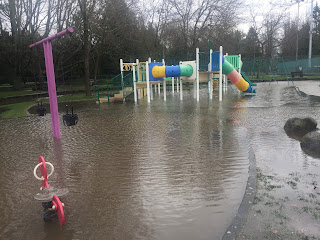When we went
outside to play at our park today, it did not look like our usual park. But
instead it was a water park. There was water everywhere.
Dayna said “the
water is too high, it will make my socks wet”. With that being said, she did
not go in the water.
On the other hand, Austin and Elliot went in
the water to see how deep it was. Both were convinced that their boots and
muddy buddy would keep them dry. Elliot said “the water is lower
than my boots”.
Keane used a stick
to measure the depth of the water. It was only the stick that was submerged in
water because he did not want to get wet.
Chelsea measured
how deep the water was by going in and using a stick. She was also interested
in seeing whether the stick and leaves float or sink.
We definitely had
a fun experience at our “water park” today. Some of the children even suggested
that they bring their bathing suits next class. Playing at the park with all
the water, gave the children the opportunity to practice their skills in
measurement (depth of water), buoyancy (float or sink) and gross motor skills (walking
in water). I wonder what the park will
look like the next time we go outside.
Until next time,
Patricia






Comments